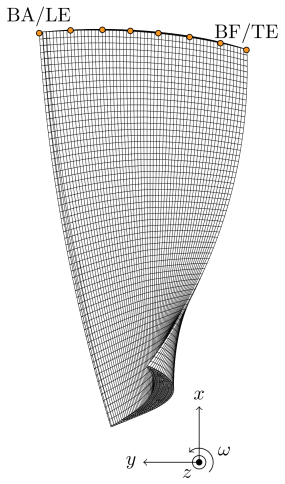NASA Rotor 67
This page contains various informations associated to one of the rotor 67 blade model used in LAVA publications.
Original model
- Original technical report [1]:
@TechReport{urasek1979design, author = {Urasek, D. C. and Gorrell, W. T. and Cunnan, W. S.}, title = {Performance of two-stage fan having low-aspect-ratio first-stage rotor blading}, institution = {NASA Lewis Research Center Cleveland, OH, United States}, note = {NASA-TP-1493, url~: \url{https://ntrs.nasa.gov/citations/19790018972}, 1979 (accessed 2021-09-09)}} - Pictures :
@Misc{huebler1977records, author = {Laity, D.}, title = {Stage 67 rotor and stage 67 casing half stators mounted. {R}ecords of the {N}ational {A}eronautics and {S}pace {A}dministration, 1903 - 2006. {P}hotographs relating to agency activities, facilities and personnel, 1973 - 2013}, note = {\href{https://catalog.archives.gov/id/17500553}{https://catalog.archives.gov/id/17500553}, 1980 (accessed 2021-09-09)}, % Fig 1 note = {\href{https://catalog.archives.gov/id/17500556}{https://catalog.archives.gov/id/17500556}, 1980 (accessed 2021-09-09)}, % Fig 2 }
Finite element mesh
- Number of nodes: 20393
- Total number of elements: 6232
- Number of degrees of freedom: 59964
- Element type: quadratic pentahedron

finite element mesh overview (coarse mesh) - LaTeX source files
- Number of nodes: 83393
- Total number of elements: 28560
- Number of degrees of freedom: 246960
- Element type: quadratic pentahedron

finite element mesh overview (refined mesh) - LaTeX source files
Material properties
- The original material of the rotor 67 is not defined in the NASA report
- Considered properties: Ti-6Al-4V, generic titanium:
- Young's modulus E = 108 GPa
- density$\rho$ = 4400 kg/m3
- Poisson's ratio $\nu$ = 0.34
- yield stress $\sigma_Y$ = 0.824 GPa
- First three predicted natural frequencies (with clamped root) for the coarse mesh:
- 1B: 2040.7 rad/s / 324.8 Hz
- 2B: 6345.9 rad/s / 1010.0 Hz
- 1T: 10734.6 rad/s / 1708.5 Hz
- First three predicted natural frequencies (with clamped root) for the refined mesh:
- 1B: 2039.7 rad/s / 324.6 Hz
- 2B: 6340.6 rad/s / 1009.1 Hz
- 1T: 10735.0 rad/s / 1708.5 Hz
Featured references from the LAVA
- Stratégie numérique pour l’analyse qualitative des interactions aube/carter [2]
Cette page contient diverses informations associées à l'un des modèles de l'aube NASA rotor 67 utilisé dans les publications du LAVA.
Modèle original
- Rapport technique original [1]:
@TechReport{urasek1979design, author = {Urasek, D. C. and Gorrell, W. T. and Cunnan, W. S.}, title = {Performance of two-stage fan having low-aspect-ratio first-stage rotor blading}, institution = {NASA Lewis Research Center Cleveland, OH, United States}, note = {NASA-TP-1493, url~: \url{https://ntrs.nasa.gov/citations/19790018972}, 1979 (accessed 2021-09-09)}} - Photographies :
@Misc{huebler1977records, author = {Laity, D.}, title = {Stage 67 rotor and stage 67 casing half stators mounted. {R}ecords of the {N}ational {A}eronautics and {S}pace {A}dministration, 1903 - 2006. {P}hotographs relating to agency activities, facilities and personnel, 1973 - 2013}, note = {\href{https://catalog.archives.gov/id/17500553}{https://catalog.archives.gov/id/17500553}, 1980 (accessed 2021-09-09)}, % Fig. 1 note = {\href{https://catalog.archives.gov/id/17500556}{https://catalog.archives.gov/id/17500556}, 1980 (accessed 2021-09-09)}, % Fig. 2 }
Maillage éléments finis
- Nombre de noeuds : 20393
- Nombre total d'éléments : 6232
- Nombre de degrés de liberté : 59964
- Type d'élément : pentaèdre quadratique

aperçu du maillage éléments finis (maillage grossier) - sources LaTeX
- Nombre de noeuds : 83393
- Nombre total d'éléments : 28560
- Nombre de degrés de liberté : 246960
- Type d'élément : quadratic pentahedron

aperçu du maillage éléments finis (maillage fin) - sources LaTeX
Propriétés matériau
- Le matériau original du rotor 67 n'est pas défini dans le rapport de la NASA
- Propriétés considérées : alliage de titane Ti-6Al-4v :
- Module d'Young E = 108 GPa
- masse volumique $\rho$ = 4400 kg/m3
- coefficient de Poisson $\nu$ = 0,34
- limite élastique $\sigma_Y$ = 0,824 GPa
- Trois premiers modes prévus (noeuds de la base encastrés) pour le maillage grossier :
- 1F : 2040,7 rad/s / 324,8 Hz
- 2F : 6345,9 rad/s / 1010,0 Hz
- 1T : 10734,6 rad/s / 1708,5 Hz
- Trois premiers modes prévus (noeuds de la base encastrés) pour le maillage fin :
- 1B: 2039,7 rad/s / 324,6 Hz
- 2B: 6340,6 rad/s / 1009,1 Hz
- 1T: 10735,0 rad/s / 1708,5 Hz
Références du laboratoire
- Stratégie numérique pour l’analyse qualitative des interactions aube/carter [2]

